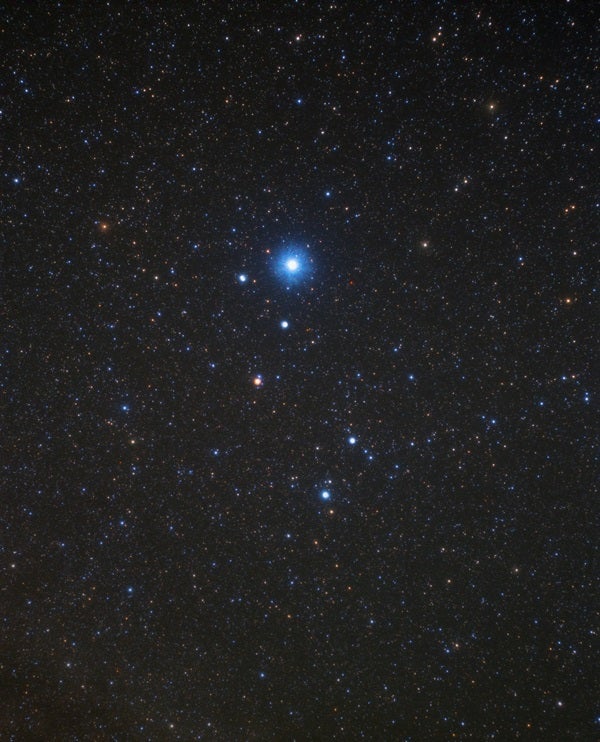The longest diagonal axis of Lyra’s parallelogram frame stretches 6° point-to-point, just small enough to squeeze into the field of most 10×50 binoculars. That makes it easy to compare the four corner stars: Zeta (ζ), Beta (β), Gamma (γ), and Delta (δ) Lyrae. It turns out that each is quite unique.
Let’s examine them in clockwise order starting from Zeta, which is at the northwest corner and closest to Vega. Zeta is a multiple-star system, with as many as seven suns involved. A quick glance shows the brightest two, a magnitude 4.3 primary star paired with a magnitude 5.6 companion to the southeast. Both are separated by 44″, so they are easy to pick out with the smallest binoculars. The Zetas are believed to lie 152 light-years away. If so, then a gap of 2,000 astronomical units (2,000 times the average Earth-Sun distance) separates one from the other.
The brighter star, Zeta A, is classified as spectral type A5m, the m standing for metallic. That reflects the star’s unusual spectrum, which shows strong absorption lines of certain metals, such as zinc and strontium, and weak lines in others.
Beta Lyrae, also known as Sheliak, is also a binary system, but with a much greater magnitude contrast than Zeta’s. Here, we find a 3.6-magnitude primary star and a 6.7-magnitude companion sun. The two are separated by 45″, making them another ideal binocular target. At least four more stars belong to the Beta family, although they elude our binoculars.
Beta is a busy stop on our tour. Not only is it a nice stellar pair to enjoy through binoculars, but the brighter sun, known as Beta A, is also an eclipsing binary. Every 12.9 days, Beta A slowly fluctuates in brightness from magnitude 3.3 to 4.3, and back again. The Beta A system is unusual in that both stars mutually cover each other as they orbit a common center of gravity. Each lies so close to the other that the complex interplay of gravity dramatically distorts them into egg-shaped ellipsoids as swirling clouds engulf both.
You can monitor Beta’s eclipses by comparing its brightness against the other stars in the Lyra trapezoid. When Beta is near maximum, its appearance matches that of Gamma Lyrae to its immediate east. When near minimum, it closely matches Zeta A.
Gamma, at the southeast corner, is a solo act. Also known by the proper name Sulafat, Gamma is a type B9 blue giant emitting over 2,400 times more energy than the Sun.
While no companion stars are physically associated with Gamma, it serves as the centerpiece for an asterism that, to me, looks like a compact, if not damaged, fan-shaped leaf rake. A trio of 5th- and 7th-magnitude stars to its northwest — SAO 67667, 67630, and 67612, east to west respectively — mark the tips of three of the rake’s blades. The rake’s handle extends half a degree from Gamma to orangish Lambda (λ) Lyrae.
The Lyre’s northeast corner is also a busy intersection. Two stars, 4.3-magnitude Delta2 and 5.6-magnitude Delta1 are cleaved by 10.3′. That’s three times wider than Epsilon (ε) Lyrae, the famous Double-Double. And like the Double-Double, the Deltas can be resolved by eye alone given dark skies.
Through binoculars, the Deltas do much more than just split. American astronomer Charles Stephenson was first to suggest that the Deltas, along with some of the fainter surrounding suns, form a weak grouping. That was back in 1959. There was some debate in the ensuing years as to whether or not the stars actually form a true cluster, but that was all put to rest in 1968. Studies conducted by a team led by American astronomer Olin Eggen proved that the cluster was real and contained some 33 members. The cluster is now appropriately nicknamed the Delta Lyrae Cluster, but is more formally known as Stephenson 1, for his original research.
I heard from reader Rob Datsko that there is an intriguing double triangle asterism within Stephenson 1. As he envisions it, orangish Delta2 forms the east-pointing apex of an obtuse triangle that includes Delta1 to the northwest and 7th-magnitude SAO 67550 to the south. Look inside that triangle and you’ll see a smaller, equilateral triangle of 8th-magnitude stars. Have you ever spotted a noteworthy pattern of stars through your binoculars? Do as Rob did and tell me about it. Contact me through my website, philharrington.net.
Until next month, remember that two eyes are better than one.










